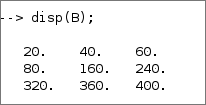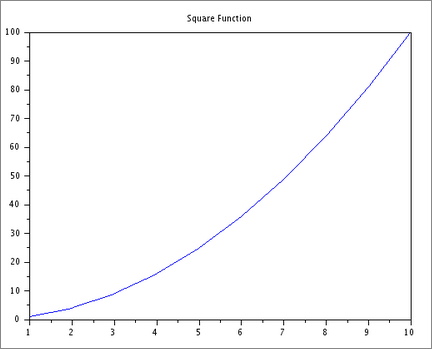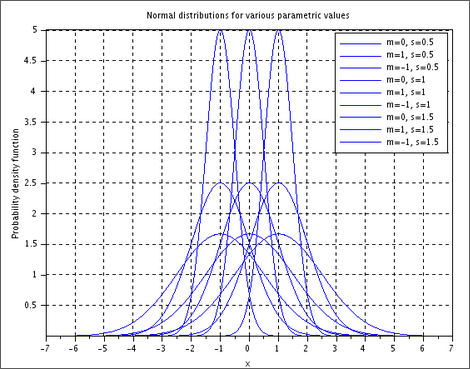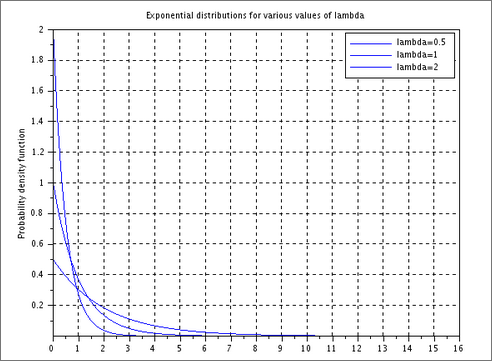8.1 KiB
Experiment 1
Objective
Installation of Scilab and demonstration of simple programming concepts like matrix multiplication (scalar and vector), loop, conditional statements and plotting.
Method
- Installed Scilab binary on desktop via nix package manager.
- Launched the binary and opened console.
-
Declared matrix and integer, evaluated the product of matrix with a scalar
Code
A = [4 8 12; 16 32 48; 64 72 80]; x = 5; B = x * A; disp(B);Output
-
Declared another matrix and evaluated the vector product
Code
A = [12 32 54; 9 4 2; 1 2 3]; B = [1 2 3; 7 2 4; 11 2 13]; x = 5; C= x * A * B; disp(C);Output
-
Declared another matrix and evaluated the dot product
Code
A = [12 32 54]; B = [1 2 3]; dot = A * B'; disp(dot);Output
-
Declared another matrix and evaluated the dot product
Code
x = 1:10; y = x .^ 2; plot(x,y); title(‘Square Function’);Output
Result
Installed Scilab and demonstrated simple programming concepts like matrix multiplication (scalar and vector), loop, conditional statements and plotting.
Experiment-2
Objective
Program for demonstration of theoretical probability limits.
Method
- Opened Scilab console and evaluated the following commands.
- Declared integer n and set it to 10000, similarly declared and set another integer head_count to 0.
- Set up a loop from 1 to 10000 and generated a random number between 0 and 1 using rand() command
- if the value of number is less then 0.5 then incremented head_count by 1
- Set up a function P(i) for probability of heads in trial.
- Plotted the graph of P(i) using plot() command.
Code
n = 10000;
head_count = 0;
for i = 1:n
x = rand(1)
if x<0.5 then
head_count = head_count + 1;
end
p(i) = head_count / i;
end
disp(p(10000))
plot(1:n,p)
xlabel("No of trials");
ylabel("Probability");
title("Probability of getting Heads");Result
Experiment 3
Objective
Program to plot normal distributions and exponential distributions for various parametric values.
a) Method: Normal Distribution
- Opened Scilab console and evaluated the following commands.
- Declared 2 arrays, m_values and s_values with various parametric values of mean and standard deviation.
- Set up a loop from 1 to length of the array ‘means’ and got a pair of values of mean and standard deviation.
- Using those values, generated the probability density function
$f(\boldsymbol{x}) = \frac{1}{s}\cdot\sqrt{2\pi}\cdot e^{\frac{-(\boldsymbol{x} - m) ^ 2}{(2 * s ^ 2)}}$
- Created a range of x values to plot the normal distribution using linspace() command.
- Correctly titled and labelled the graph.
- Plotted various normal distribution curves using plot() command.
a) Code
m_values = [0, 1, -1];
s_values =[0.5, 1, 1.5];
for m = m_values
for s =s_values
t =grand(1, 1000, "nor", m, s);
x= linspace(m-4*s, m+4*s, 1000)
y = (1/s*sqrt(2*%pi))*exp(-(x - m).^2/(2*s^2));
plot(x, y);
hold on;
xgrid();
end
end
legend("m=0, s=0.5", "m=1, s=0.5", "m=-1, s=0.5",...
"m=0, s=1" , "m=1, s=1" , "m=-1, s=1", ...
"m=0, s=1.5", "m=1, s=1.5", "m=-1, s=1.5");
xlabel("x")
ylabel("Probability density function");
title("Normal distributions for various parametric values");b) Method: Exponential Distribution
- Opened Scilab console and evaluated the following commands.
- Declared an array, Lambda_values with various values of lambda
- Set up a loop from 1 to length of the array Lambda_values and the function grand() is used to generate 1000 random numbers from the exponential distribution.
- Using those values, generated the probability density function
$f(x) = Y = lambda \cdot e^{-lambda \cdot x}$
- Created a range of x values to plot the exponential distribution using linspace() command.
- Correctly titled and labelled the graph.
- Plotted various exponential distribution curves using plot() command.
b) Code
lambda_values = [0.5, 1, 2];
for lambda = lambda_values
t = grand(1, 1000, "exp", lambda);
x = linspace(0, 8/lambda, 1000);
y = lambda * exp(-lambda * x);
plot(x, y);
xgrid();
hold on;
end
xlabel("x");
ylabel("Probability density function");
title("Exponential distributions for various values of lambda");
legend(["lambda=0.5", "lambda=1", "lambda=2"]);Experiment 4
Objective
Program to plot normal distributions and exponential distributions for various parametric values.
Theory
Binomial Distribution: A probability distribution that summarizes the likelihood that a variable will take one of two independent values under a given set of parameters. The distribution is obtained by performing a number of Bernoulli trials. A Bernoulli trial is assumed to meet each of these criteria:
- There must be only 2 possible outcomes.
- Each outcome has a fixed probability of occurring. A success has the probability of p, and a failure has the probability of 1 – p.
- Each trial is completely independent of all others.
- To calculate the binomial distribution values, we can use the binomial distribution formula:
$P(X = x) = {}^{n}C_{x} \cdot p^x \cdot (1 - p)^{n - x}$
where `n` is the total number of trials, `p` is the probability of success, and `x` is the number of successes. We can calculate the binomial distribution values for each possible value of `x` using this formula and the values of `n` and `p` given above.
Problem statement
6 fair dice are tossed 1458 times. Getting a 2 or a 3 is counted as success. Fit a binomial distribution and calculate expected frequencies.
Method
- Find the number of cases, times the experiment is repeated, and the probability of success.
- Here, we have to find the Binomial Probability Distribution, which is defined as:
$P(X = x) = \frac{n!}{x! \cdot (n-x)!} \cdot s^x \cdot (1 - s)^{n - x}$
Calculate it.
- Calculate the frequency, which is given by E= P*N.
- Put the calculated values in the table below.
| x | Expected Frequency | Binomial Distribution P (X = x) |
|---|---|---|
| 0 | 28.43 | 0.004831 |
| 1 | 181.83 | 0.003107 |
| 2 | 547.50 | 0.009387 |
| 3 | 1009.53 | 0.017307 |
| 4 | 1213.50 | 0.020803 |
| 5 | 947.25 | 0.016255 |
| 6 | 312.50 | 0.002132 |
Steps
- Find the number of cases, here, we take it as n.
- Find the probability of success. Here, we take it as s (=2/6).
- Define the number of times the process is repeated, and mark it as N. Here, acc to question, it’s 1458.
- Take a variable x that varies from 0 to number of cases.
- Apply the Formula for Binomial Probability Distribution.
- Apply the formula for the Frequency.
- Plot the Graph.
Code
n=6;
s=1/3;
N=1458;
x=0:n;
P= (1-s).^(n-x).*s.^x.*factorial(n)./(factorial(x).*factorial(n-x));
E= P*N;
clf();
plot(x,E,"b.-");






